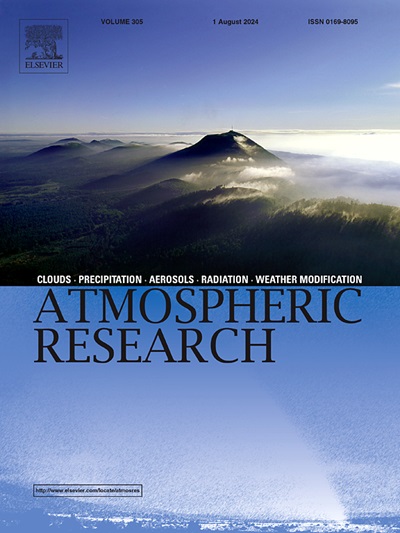Quantitative study of snow sublimation in the Altai Mountains
IF 4.5
2区 地球科学
Q1 METEOROLOGY & ATMOSPHERIC SCIENCES
引用次数: 0
Abstract
The sublimation of snow has a major impact on the global climate. We present a simple empirical formula that allows snow sublimation to be quantified on the interannual scale in the Altai Mountains. This empirical formula is based on the fitting of measured temperature and snow water equivalent (SWE) data for midwinter collected between 2011 and 2018 at the Koktokay snow station, located at the outlet of the Kayiertesi River Basin. The results suggest that there is a best-fitting linear relationship (r = −0.98; p < 0.001) between the temperature and snow sublimation rates. The low sublimation rate, which was only 0.2 mm day−1, corresponded to a low air temperature and high relative humidity, and the sublimation loss accounted for 2.6 % and 5.6 % of the annual precipitation and snowfall, respectively. Based on the proposed empirical formula and the hourly meteorological data from the ERA5 Land reanalysis, we calculated the sublimation rate in the Irtysh River Basin from 2011 to 2018. The results reveal that the cumulative snow sublimation loss was 14.3 mm y−1, comprising 8.2 % of the snowfall and 3.9 % of the annual precipitation. Due to the relative ease of collecting field observations of the temperature and SWE, this simple formula, which has a high level of goodness of fit, is more applicable to the study of issues related to snow mass balance over long time scales in the Altai Mountains, and it also provides support for local snowmelt flood warning and water resource management.
阿尔泰山积雪升华的定量研究
雪的升华对全球气候有重大影响。我们提出了一个简单的经验公式,可以在年际尺度上量化阿尔泰山的雪升华。该经验公式基于2011年至2018年在克耶尔特斯河流域出口的Koktokay雪站收集的隆冬实测温度和雪水当量(SWE)数据的拟合。结果表明,存在最佳拟合线性关系(r = - 0.98;p & lt;0.001),在温度和雪升华率之间。低升华率(仅为0.2 mm day - 1)对应着低气温和高相对湿度,升华损失分别占年降水量和降雪量的2.6%和5.6%。基于经验公式和ERA5陆地再分析逐时气象数据,计算了2011 - 2018年额尔齐斯河流域的升华率。结果表明,累计积雪升华损失为14.3 mm y - 1,占降雪量的8.2%和年降水量的3.9%。由于温度和SWE的野外观测相对容易采集,该简单公式具有较高的拟合优度,更适用于研究阿尔泰山地区长时间尺度的雪质量平衡问题,并为当地融雪洪水预警和水资源管理提供支持。
本文章由计算机程序翻译,如有差异,请以英文原文为准。
求助全文
约1分钟内获得全文
求助全文
来源期刊

Atmospheric Research
地学-气象与大气科学
CiteScore
9.40
自引率
10.90%
发文量
460
审稿时长
47 days
期刊介绍:
The journal publishes scientific papers (research papers, review articles, letters and notes) dealing with the part of the atmosphere where meteorological events occur. Attention is given to all processes extending from the earth surface to the tropopause, but special emphasis continues to be devoted to the physics of clouds, mesoscale meteorology and air pollution, i.e. atmospheric aerosols; microphysical processes; cloud dynamics and thermodynamics; numerical simulation, climatology, climate change and weather modification.
 求助内容:
求助内容: 应助结果提醒方式:
应助结果提醒方式:


